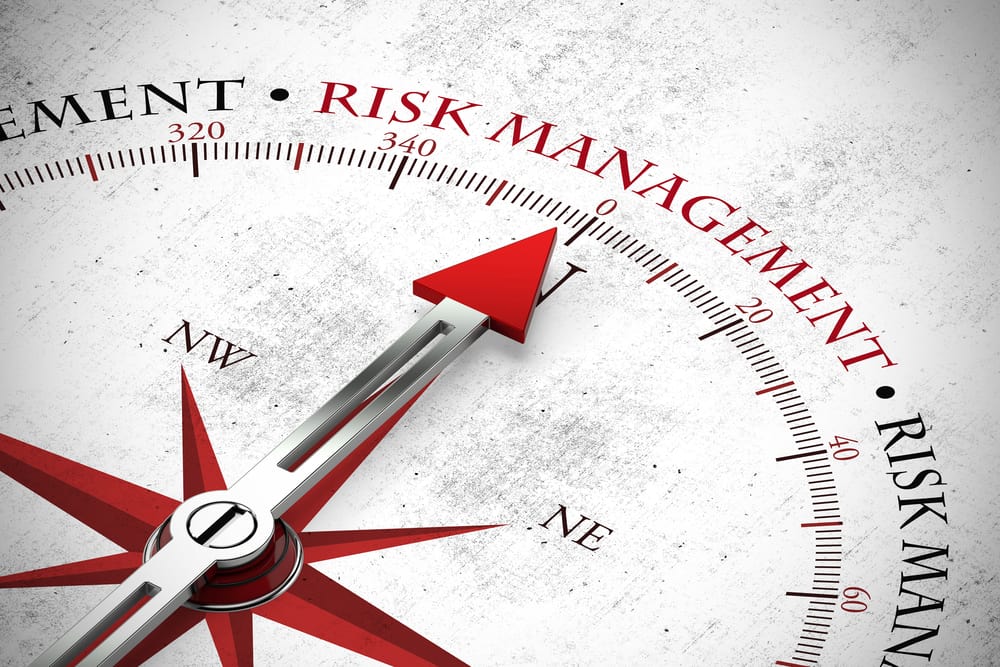
If you’re a forex trader, you probably already know that practising good forex risk management can allow you to minimize losses and trade more profitably in the long term. Putting a solid forex risk management plan in place tends to help you stay in control as a trader and can also really limit the amount of stress involved in currency trading.
Today, we’re going to look at the basic rules involved in employing good risk management in forex trading. We’ll cover how to use stop loss and take profit limits, guidelines around using leverage and margin, and understanding risk-reward ratios, as well as how to develop good general trading psychology.
Managing Risk When Trading Forex
There are various strategies that traders can use to help them manage risk when forex trading, which allows traders to protect themselves from large losses and maximize trading profits. It is important to accept that forex trading is inherently risky and that the more risk you take, the higher the chance of both bigger returns when the trade goes in your favour, and significant losses when it goes against you.
Risk management is not just about fuzzy concepts like ‘being cautious’ or ‘controlling your emotions’. It’s about specific actions that traders can take, such as establishing the correct position size, setting stop loss and take profit limits and using leverage and margin wisely. However, it is also linked to the psychology of trading, and the ability to trade rationally rather than impulsively. If you set firm parameters around when you want to exit and enter positions, you are less likely to let emotions get the better of you and enter positions on a whim.
Stop Losses and Take Profits
When you set a stop loss limit you are determining the price of an asset at which the position will get closed in order to limit your potential loss on this particular trade. The stop loss price will obviously be lower than the current price of the asset you are trading and is designed to limit your losses if a trade goes against you.

A take profit limit is similar, but it is a predetermined price, higher than the current one, at which you will close a position that is going in your favour and take your profit. Take profit limits are often set using technical analysis tools and aim to allow you to close the position and walk away with a profit before the price of the asset starts its next downturn. A take profit order is often set by short-term traders who are aiming to profit from a quick rise in the price of a specific asset.
Leverage and Margin
In forex trading, margin refers to the deposit amount needed to place a trade and keep a position open. When trading forex on margin, you only need a percentage of the full value of the position in order to open a trade, so trading with margin essentially lets you increase your exposure to the market relative to the funds you have on deposit. This is generally seen by traders as a positive thing but it does mean that both profits and losses are amplified.
Leverage is a concept that is closely related to margin. It enables you to trade larger position sizes with a smaller capital outlay because you are using your own money along with leverage that you effectively borrow from your broker. The leverage available to a trader depends on the margin requirements of the broker, and often on the leverage limits as stipulated by the relevant regulatory body. In the UK and throughout the EU, for example, forex leverage is limited to a maximum of 30:1, but offshore traders may offer much higher leverage.
When you trade using leverage and margin you are taking an extra risk, because relatively small price movements can lead to much bigger losses, and profits of course, than you would otherwise experience. Make sure you fully understand leverage and margin, and trade with levels that are appropriate for you, your situation and your trading budget.
Brokers who offer negative balance protection will usually close any open positions if your account can no longer meet the margin requirements. This seems like a good thing and can be used as a part of your risk management strategy. However, it takes the control as to when those positions are closed out of your hands, so it could result in unexpected losses. Therefore, it is vital to understand how negative balance protection works before you start trading on margin.
Position Size
Choosing the correct amount to invest in each trade is also an important factor in forex risk management. Selecting the right position size, or the number of lots you take on a trade, will both protect your account against losses and maximize your opportunities.
Experienced traders use a range of factors to decide on position size, including risk percentage, their account size, appetite for risk, pip cost and lot size. However, there are also some very general guideline percentages that traders tend to stick to, and it is generally acknowledged that using no more than 1-3% of your account funds on a single trade is advisable from a risk management perspective.
Risk-reward Ratios
The risk-reward ratio refers to the potential reward a trader will receive for every dollar they risk on a specific trade, so it is used to compare the expected return on an investment with the amount of risk that must be taken on. If a trade is determined to have a risk-reward ratio of 1:7, for example, then for every $1 that the trader ‘risks’ on that trade, the reward is estimated to be $7. Every trader will have their own ideas about what is an acceptable risk-reward ratio, but most will be looking for a ratio of 1:3 or higher.

Traders calculate the ratio by dividing the amount they could lose if the price of an asset moves in the opposite direction to what they were expecting, by the amount of profit they expect to make when the position is closed. This means the risk-reward ratio basically measures the difference between a trade entry point to a stop loss or take profit order. Comparing the two provides the ratio of profit to loss, or reward to risk.
It is common to use stop loss orders to help minimize losses in forex trading, and traders can make decisions on where to set their stop loss and take profit levels, keeping their risk-reward ratio in mind. Stop loss and take profit levels can be used to calculate the risk-to-reward ratio of any given trade using the formula:
- (Entry price – Stop-loss price) divided by (Take-profit price – entry price)
Trading Psychology
When it comes to forex trading and risk management, there are many aspects of an individual trader that will help determine whether they are successful with their trading activities or not. For example, their experience, skill and knowledge of things such as technical and fundamental analysis. However, trading psychology can also have a big impact on a trader’s success.
Trading psychology refers to the mental state of the trader and how that impacts his or her decisions while trading. It is important to take control of your emotions when trading and trade based on unbiased decisions, not on a whim. We have likely all heard a story about a trader who made a fortune on a specific trade based on a ‘gut instinct’ but this is the exception, not the rule, and trading based on instinct or intuition is not likely to be profitable long-term.
Trading can be stressful, and natural human emotions such as greed or fear can easily interfere with a trader’s ability to make calm and rational decisions. Traders can also find that they become a victim of their own biases, such as the ‘gambler’s fallacy’ bias where the trader believes that a particular event is more likely to occur because of past events. For example, the assumption that if a currency is moving in one direction, that will continue indefinitely, whereas, in practice, currencies tend to constantly fluctuate up and down.
Developing good trading psychology is about a lot more than ‘controlling your emotions’. It is about being rational in your trading decisions and learning to trade based on solid technical and fundamental analysis rather than emotional decisions or gut reactions. It is about putting a trading plan in place, based on the goals you have set for yourself, and following the trading strategies that best suit your objectives.
It is also about using trading tools, such as the risk-reward ratio, stop loss and take profit levels, leverage and margin and technical indicators, in order to make decisions as to when to enter and exit positions in advance, as opposed to deciding these things based on emotions and instinct while the trade is in process.
Related Articles
- What are Leverage and Margin in Forex Trading?
- Risk Management Tools for Trading Forex
- Risk Management Strategies for Forex Trading
Safe Forex Brokers
Even an excellent risk management strategy can only be implemented if you have a good, reliable broker that offers you all the tools and features you need to put your risk management actions in place. Here is our table of safe, recommended brokers:
| Broker | Features | Min Deposit | EURUSD Spread | ||
|---|---|---|---|---|---|
 Your capital is at risk
US Clients: No Regulated : Yes Your capital is at risk
US Clients: No Regulated : Yes
|
– Regulated by FCA, FSCA, CMA and FSC |
$200 | ECN 0.1, Standard 1.6 | ||
 Your capital is at risk
US Clients: No Regulated : Yes Your capital is at risk
US Clients: No Regulated : Yes
|
– 40% New Member Bonus
|
$100 | Fixed |
Sign
Up
Europe* CFDs are complex instruments and come with a high risk of losing money rapidly due to leverage. 79% of retail investor accounts lose money when trading CFDs with this provider. You should consider whether you understand how CFDs work and whether you can afford to take the high risk of losing your money.
|
|
 Between 74-89 % of retail investor accounts lose money when trading CFDs
US Clients: No Regulated : Yes Between 74-89 % of retail investor accounts lose money when trading CFDs
US Clients: No Regulated : Yes
|
|
$200 | NDD 0.09 / Standard 0.69 |
Sign
Up
Between 74-89 % of retail investor accounts lose money when trading CFDs
|
|
 * 82% of retail investor accounts lose money when trading CFDs with this provider. You should consider whether you can afford to take the high risk of losing your money
US Clients: No Regulated : Yes * 82% of retail investor accounts lose money when trading CFDs with this provider. You should consider whether you can afford to take the high risk of losing your money
US Clients: No Regulated : Yes
|
|
100GBP/AUD/EUR/USD | variable |
Sign
Up
* 82% of retail investor accounts lose money when trading CFDs with this provider. You should consider whether you can afford to take the high risk of losing your money
|
|
 Your capital is at risk
US Clients: No Regulated : Yes Your capital is at risk
US Clients: No Regulated : Yes
|
– Flexible leverage up to 500:1 |
$200 | From 0.1 | ||
 Your capital is at risk
US Clients: No Regulated : Yes Your capital is at risk
US Clients: No Regulated : Yes
|
$50 | 0.02 | |||
 61% of retail CFD accounts lose money
US Clients: No Regulated : Yes 61% of retail CFD accounts lose money
US Clients: No Regulated : Yes
|
|
$50 (varying by Country) | from 1 |
Sign
Up
*Don’t invest unless you’re prepared to lose all the money you invest. This is a high-risk investment and you should not expect to be protected if something goes wrong. Take 2 mins to learn more
|
|
 Your capital is at risk
US Clients: No Regulated : Yes Your capital is at risk
US Clients: No Regulated : Yes
|
|
$5 | From 0.0 pips | ||
 Your capital is at risk
US Clients: No Regulated : Yes Your capital is at risk
US Clients: No Regulated : Yes
|
– CySEC, FCA, FSCA, SCB Regulated |
$100 | |||
|
|
|||||
Ultimately, employing good risk management in forex trading is one of many things that can have a positive impact on your trading success, and help you make a profit as often as possible while limiting the extent of those occasional inevitable losses. Risk management is, in many ways, intertwined with most common forex trading strategies. Learning to use such strategies is part of what helps new traders to make rational decisions about how to trade forex, and in particular, when to enter and exit positions, which is what good risk management is all about.
Forex risk management is about learning to use forex trading tools and strategies to make decisions about when and how to trade. These tools can and do include technical indicators, fundamental analysis, placing stop loss and take profit orders, and using leverage and margin wisely, and at sensible levels, when making decisions about your overall forex trading aims and objectives.
It is also about developing the right mindset and a healthy mental attitude regarding forex trading. Money is an emotional topic, and it may be impossible to completely remove your own feelings from your trading activities. However, good trading discipline, developed as part of a well-planned out forex risk management strategy, will help you to trade based on rational decisions, with consistent success as your over-riding goal. This will in turn help you to put each trade in context and accept and limit losses, while aiming for trading profits over the long term.